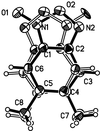issue contents
October 2012 issue

Cover illustration: A high-angle annular darkfield scanning transmission electron microscopy image of the decagonal quasicrystal Al72Co8Ni20 overlaid with a structure model. Clusters of type 1 (occupied center) highlight transition metal sites (white spheres) and clusters of type 2 (empty center) possess both transition metal and mixed aluminum/transition metal (red) sites. Decagonal-shaped clusters are outlined and exhibit two types of overlap as a unifying building feature of aperiodic quasicrystals of decagonal Al-Co-Ni, Al-Co-Cu and Al-Fe-Ni [Deloudi et al. (2011). Acta Cryst. B67, 1-17, based on Abe & Tsai (2004) J. Non-Cryst. Solids, 334, 198-201]. The 2011 Nobel prize in chemistry was awarded to D. Shechtman for his discovery of quasicrystals.
research papers










Four types of the title compound are identified, which differ in the stacking of planar layers of the nearly flat molecules. Polytypism is induced by variation of the conditions of crystallization.




 journal menu
journal menu

























